高中英语语法总结
高中英语语法整理总结归纳大全
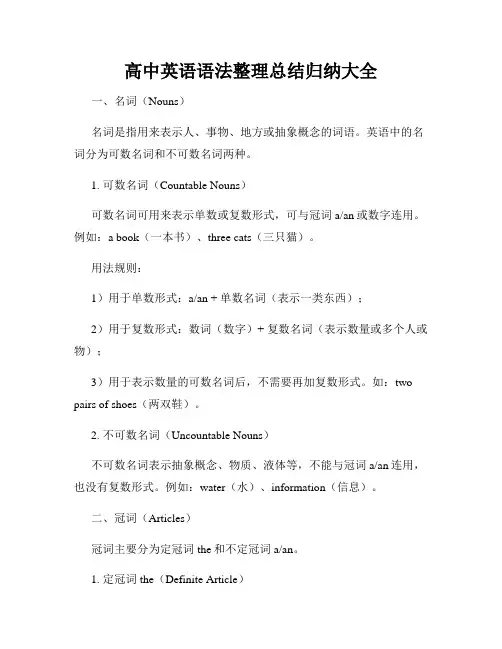
高中英语语法整理总结归纳大全一、名词(Nouns)名词是指用来表示人、事物、地方或抽象概念的词语。
英语中的名词分为可数名词和不可数名词两种。
1. 可数名词(Countable Nouns)可数名词可用来表示单数或复数形式,可与冠词a/an或数字连用。
例如:a book(一本书)、three cats(三只猫)。
用法规则:1)用于单数形式:a/an + 单数名词(表示一类东西);2)用于复数形式:数词(数字)+ 复数名词(表示数量或多个人或物);3)用于表示数量的可数名词后,不需要再加复数形式。
如:two pairs of shoes(两双鞋)。
2. 不可数名词(Uncountable Nouns)不可数名词表示抽象概念、物质、液体等,不能与冠词a/an连用,也没有复数形式。
例如:water(水)、information(信息)。
二、冠词(Articles)冠词主要分为定冠词the和不定冠词a/an。
1. 定冠词the(Definite Article)the用于特定或特指的人或物之前,表示这个人或物已知或被提及过。
例如:the teacher(这个老师)、the book(这本书)。
用法规则:1)用于特定名词的前面,如:the boy(这个男孩);2)用于特定地点或方向,如:the park(这个公园);3)用于乐器名词前,如:the piano(这个钢琴);4)用于表示一类事物的复数名词前,如:the animals(这些动物)。
2. 不定冠词a/an(Indefinite Article)a/an表示泛指或不特定的人或物,在初次提到的时候使用。
例如:a cat(一只猫)、an apple(一个苹果)。
用法规则:1)a用于以辅音音素开头的单词前,如:a book(一本书);2)an用于以元音音素开头的单词前,如:an hour(一个小时);3)a/an不可与可数名词的复数形式连用。
三、代词(Pronouns)代词是用来代替名词的词语,可以用来避免重复,分为人称代词、物主代词、反身代词和指示代词等。
高中英语语法大全归纳总结
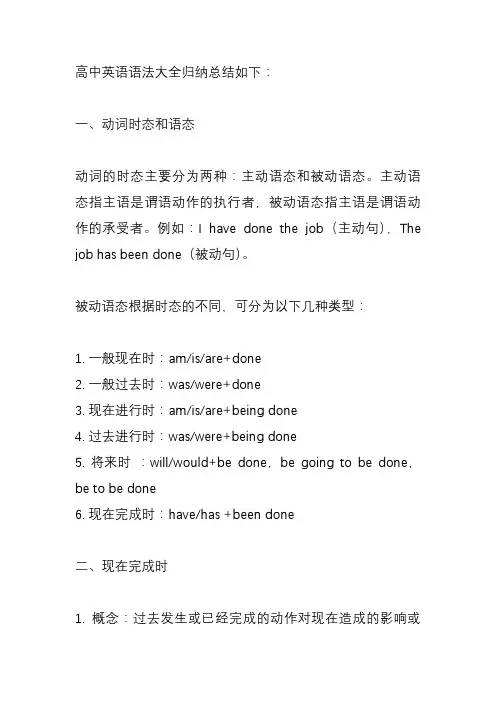
高中英语语法大全归纳总结如下:一、动词时态和语态动词的时态主要分为两种:主动语态和被动语态。
主动语态指主语是谓语动作的执行者,被动语态指主语是谓语动作的承受者。
例如:I have done the job(主动句),The job has been done(被动句)。
被动语态根据时态的不同,可分为以下几种类型:1. 一般现在时:am/is/are+done2. 一般过去时:was/were+done3. 现在进行时:am/is/are+being done4. 过去进行时:was/were+being done5. 将来时:will/would+be done,be going to be done,be to be done6. 现在完成时:have/has +been done二、现在完成时1. 概念:过去发生或已经完成的动作对现在造成的影响或结果,或从过去已经开始,持续到现在的动作或状态。
2. 时间状语:yet,already,just,never,ever,so far,by now,since+时间点,for+时间段,recently,lately,in the past few years等。
3. 基本结构:主语+have/has +p.p(过去分词)+其它4. 否定形式:主语+have/has + not +p.p(过去分词)+其它5. 一般疑问句:have或has。
6. 例句:I've written an article.我已经写了一篇论文。
The countryside has changed a lot in the past few years.在过去的几年,农村发生了巨大的变化。
以上内容仅供参考,建议查阅高中英语教材或语法书获取更多有用的内容。
高中英语语法归纳总结
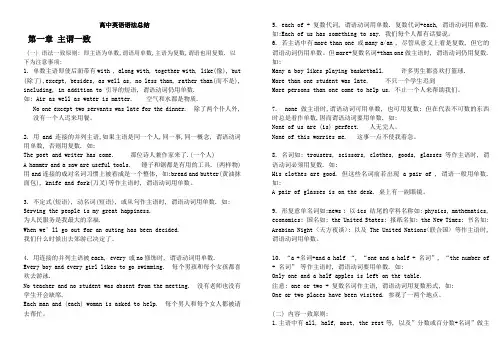
高中英语语法总结第一章主谓一致(一) 语法一致原则: 即主语为单数,谓语用单数,主语为复数,谓语也用复数. 以下为注意事项:1. 单数主语即使后面带有with , along with, together with, like(像), but (除了),except, besides, as well as, no less than, rather than(而不是), including, in addition to 引导的短语, 谓语动词仍用单数.如: Air as well as water is matter. 空气和水都是物质.No one except two servants was late for the dinner. 除了两个仆人外, 没有一个人迟来用餐。
2. 用and连接的并列主语,如果主语是同一个人,同一事,同一概念, 谓语动词用单数, 否则用复数. 如:The poet and writer has come. 那位诗人兼作家来了.(一个人)A hammer and a saw are useful tools. 锤子和锯都是有用的工具. (两样物)用and连接的成对名词习惯上被看成是一个整体, 如:bread and butter(黄油抹面包), knife and fork(刀叉)等作主语时, 谓语动词用单数。
3. 不定式(短语), 动名词(短语), 或从句作主语时, 谓语动词用单数. 如: Serving the people is my great happiness.为人民服务是我最大的幸福.When we’ll go o ut for an outing has been decided.我们什么时候出去郊游已决定了。
4. 用连接的并列主语被each, every 或no修饰时, 谓语动词用单数.Every boy and every girl likes to go swimming. 每个男孩和每个女孩都喜欢去游泳.No teacher and no student was absent from the meeting. 没有老师也没有学生开会缺席.Each man and (each) woman is asked to help. 每个男人和每个女人都被请去帮忙。
超级全的高中英语语法总结
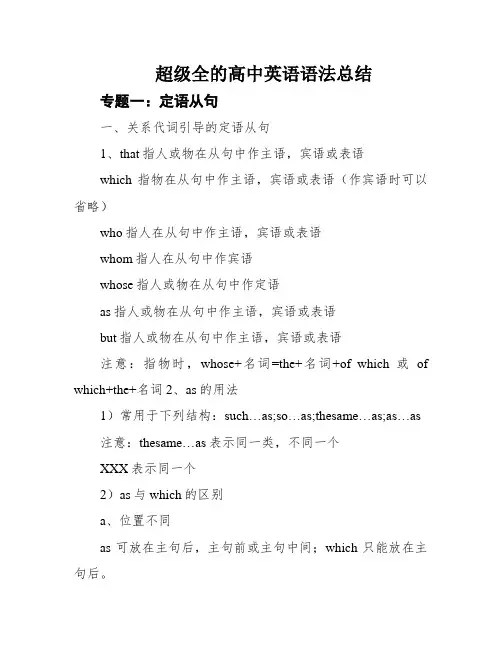
超级全的高中英语语法总结专题一:定语从句一、关系代词引导的定语从句1、that指人或物在从句中作主语,宾语或表语which指物在从句中作主语,宾语或表语(作宾语时可以省略)who指人在从句中作主语,宾语或表语whom指人在从句中作宾语whose指人或物在从句中作定语as指人或物在从句中作主语,宾语或表语but指人或物在从句中作主语,宾语或表语注意:指物时,whose+名词=the+名词+of which或of which+the+名词2、as的用法1)常用于下列结构:such…as;so…as;thesame…as;as…as注意:thesame…as表示同一类,不同一个XXX表示同一个2)as与which的区别a、位置不同as可放在主句后,主句前或主句中间;which只能放在主句后。
b、as起连接作用,表达说话人的观点、看法,并指出主句内容的根据或出处,意为“正如,正像”。
Which相当于并列句,可以用and this来代替,意为“这一点,这件事’”。
注意:as常用于下列结构:as we know/ as is known to all。
as we all cansee。
as has been said before/above。
as might be excepted。
as is often the case,一般不能用which 代替as。
c、在从句中作主语时,which既可作系动词be的主语也可作实义动词的主语,而as只可作系动词be的主语。
二、只用that不用which的情形1.先行词为all。
much。
everything。
nothing。
something。
anything,nothing。
none。
the one等不定代词时2、先行词被only。
any。
few。
little。
no。
all。
just。
very。
right等修饰时.3、当先行词是第一流或被形容词第一流修饰时。
4、当先行词是序数词或被序数词修饰时。
高中英语语法归纳大总结
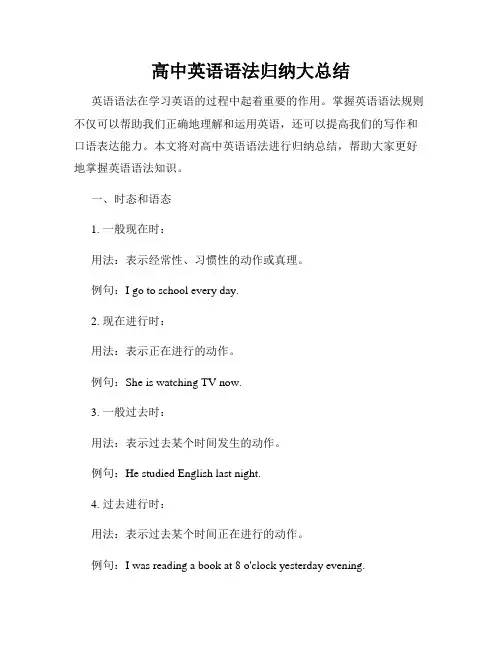
高中英语语法归纳大总结英语语法在学习英语的过程中起着重要的作用。
掌握英语语法规则不仅可以帮助我们正确地理解和运用英语,还可以提高我们的写作和口语表达能力。
本文将对高中英语语法进行归纳总结,帮助大家更好地掌握英语语法知识。
一、时态和语态1. 一般现在时:用法:表示经常性、习惯性的动作或真理。
例句:I go to school every day.2. 现在进行时:用法:表示正在进行的动作。
例句:She is watching TV now.3. 一般过去时:用法:表示过去某个时间发生的动作。
例句:He studied English last night.4. 过去进行时:用法:表示过去某个时间正在进行的动作。
例句:I was reading a book at 8 o'clock yesterday evening.5. 将来时:用法:表示将要发生的动作或存在的状态。
例句:I will go to the beach tomorrow.6. 被动语态:用法:表示主语是动作的承受者,强调动作的对象。
例句:The book was written by him.二、虚拟语气1. 条件句中的虚拟语气:用法:表示对现在或将来的假设、愿望或建议。
例句:If I were you, I would study harder.2. 虚拟语气与情态动词:用法:情态动词should, would, could等与动词原形连用表示虚拟语气。
例句:She suggested that we should go to the cinema.三、从句1. 名词性从句:用法:作主语、宾语、表语或同位语。
例句:What he said is true.2. 定语从句:用法:修饰名词或代词。
例句:The book that I borrowed is very interesting.3. 状语从句:用法:表示时间、条件、原因、结果等。
高中英语语法总结
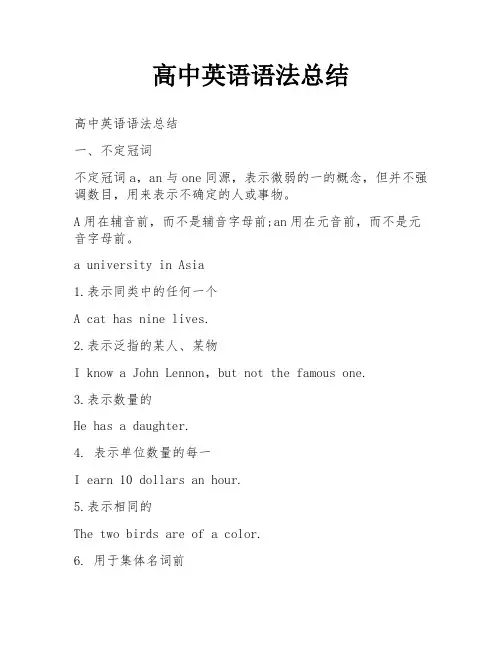
高中英语语法总结高中英语语法总结一、不定冠词不定冠词a,an与one同源,表示微弱的一的概念,但并不强调数目,用来表示不确定的人或事物。
A用在辅音前,而不是辅音字母前;an用在元音前,而不是元音字母前。
a university in Asia1.表示同类中的任何一个A cat has nine lives.2.表示泛指的某人、某物I know a John Lennon,but not the famous one.3.表示数量的He has a daughter.4. 表示单位数量的每一I earn 10 dollars an hour.5.表示相同的The two birds are of a color.6. 用于集体名词前He grows up in a large family.7. 在某种情况下可用于抽象名词和物质名词前China has a long history.二、定冠词的用法1.表示特定的人或物2.表示地球、宇宙中独一无二的事物主要指各种天体及世界上比较有影响的物体。
The sun,the moon,the earth3.表示地点、方向、时间、方式等 at the corner 在拐角处1) 在表示季节的名词前常不用冠词。
In spring 在春天2) 具体某年的某个季节,需用冠词。
In the summer of the year20083)用于序数词或形容词的最高级前 the first the second4)用于形容词前使其名词化 the rich the poor5)用于复数姓氏前,表示―夫妇‖或全家 The Smiths6)用于乐器名词前 Play the piano7)用于by+the+计量单位名词 By the pound1. 用于复数名词前复数名词泛指某类人或物时,其前通常用零冠词。
Students should obey the school rules. 学生应该遵守校规。
高中英语语法知识点总结
高中英语语法知识点总结高中英语语法是英语学习中的重要组成部分,掌握好语法知识对于提高英语成绩和语言运用能力至关重要。
以下是对高中英语语法知识点的一个较为全面的总结。
一、词法(一)名词1、名词的分类:普通名词(可数名词和不可数名词)和专有名词。
2、可数名词的复数形式:规则变化(如加 s、es 等)和不规则变化。
3、名词的所有格:'s 所有格和 of 所有格的用法。
(二)冠词1、不定冠词 a/an 的用法:表示泛指,用于单数可数名词前。
2、定冠词 the 的用法:表示特指、独一无二的事物、上文提到过的事物等。
3、零冠词的用法:在一些特定的情况下,名词前不用冠词。
(三)代词1、人称代词:主格和宾格的用法。
2、物主代词:形容词性物主代词和名词性物主代词的用法。
3、指示代词:this, that, these, those 的用法。
4、不定代词:some, any, no, none, all, both, neither, either, many, much, few, a few, little, a little 等的用法。
(四)数词1、基数词和序数词的构成和用法。
2、分数、小数、百分数的表达。
(五)形容词和副词1、形容词的用法:在句中作定语、表语、宾语补足语等。
2、副词的用法:在句中作状语,修饰动词、形容词、副词或整个句子。
3、形容词和副词的比较级和最高级:规则变化和不规则变化,以及比较级和最高级的用法。
(六)动词1、动词的时态:一般现在时、一般过去时、一般将来时、现在进行时、过去进行时、将来进行时、现在完成时、过去完成时、将来完成时、现在完成进行时。
2、动词的语态:主动语态和被动语态的构成和用法。
3、非谓语动词:动词不定式、动名词、分词(现在分词和过去分词)的用法。
(七)介词1、常用介词的用法:如 at, in, on, for, of, with, by, from, to 等。
2、介词短语的用法。
干货高中英语语法归纳总结大全,高考必备
干货高中英语语法归纳总结大全,高考必备1.定语从句引导定语从句的关系代词有that,which,who(宾格whom),所有格whose)和关系副词where when why 等,关系代词或关系副词在定语从句中充当一个成分,关系代词that,which,who,whom等在从句中分别作主语或宾语,whose 在从句中作定语,而关系副词when,where,why等在从句中作状语。
如:①I will never forget the days when/in which we worked together.②I will never forget the days which/that we spent together.解析:在句①中,表示时间的名词the days在从句中充当的是状语,所以用关系副词when来代指,引导定语从句修饰先行词the days;而在句②中,表示时间的名词the days在从句中充当的是动词spent的宾语,所以用关系代词that或which来代指。
同样,表示地点或原因的名词如果在从句中作状语,则用关系副词where 或why 来代指;如果在从句中作动词的宾语,则用which或that来代替。
如:①This is the factory where/in which I worked.(作状语)②This is the factory that/which I visited years ago.(作宾语)注:当先行词为time,reason, place时,引导词可以省略。
①This was the first (when/what) I had serious trouble with my boss.②That is the reason (why) I did it.③This is the place (where) we met yesterday.另外,定语从句中谓语动词的数应与先行词的数相一致。
高中英语语法总结归纳
高中英语语法总结归纳高中英语语法总结归纳1.as...as...引导的比较级:(1)“as +形容词或副词原级+as+被比较对象”结构。
例句: He studies as hard as you. 他像你一样学习努力。
(2)在否定句或疑问句中可用not so…as…. 例句:He can notrun so/as fast as you. 他没你跑得快。
2.only引导的倒装句型:only +状语 (或状语从句)位于句首时,句子部分倒装。
例句: Only by diligence and honesty can one succeed inlife. 只有勤奋、正直,一个人在生活中才能成功。
注意:但 only修饰主语时,不倒装。
例句: Onlythat girl knew how to work out the problem. 只有那位女生知道怎样解那道题。
3.wish引导的虚拟语气:wish 后面的从句,当表示与事实相反的情况,或表示将来不太可能实现的愿望时,其宾语从句的动词形式为:⑴表示对现在情况的虚拟:从句动词用过去式或过去进行式表示,be 的过去式用were.I wish I knew the answer to the question. 我希望知道这个问题的答案。
(可惜不知道。
)⑵表示对过去情况的虚拟:从句动词用had +过去分词。
I wish (that) I hadn’t wastedso much time. 我后悔不该浪费这么多时间。
( 实际上已经浪费掉了。
)⑶表示对将来的主观愿望:谓语动词形式为“would/ shou ld/ could/ might +动词原形”。
在这种情况下,主句的主语与从句的主语不能相同,因为主句的主语所期望的从句动作能否实现,取决于从句主语的态度或意愿(非动作名词除外) 。
I wish it would stop raining. 但愿雨能停止。
高中英语语法点总结
高中英语语法点总结高中英语语法点总结高中英语语法点总结篇1(1)现在分词与过去分词作状语的区别。
现在分词做状语与过去分词做状语的最主要区别在于两者与所修饰的主语的主动与被动关系的区别。
1)现在分词作状语时,现在分词的动作就是句子主语的动作,它们之间的关系是主动关系。
He went out shutting the door behind him. 他出去后将门随手关上。
Not knowing what to do, he went to his parents for help. 由于不知如何办是好,他去找父母帮忙。
2)过去分词作状语时,过去分词表示的动作是句子主语承受的动作,它们之间的关系是被动关系。
Given more attention, the trees could have grown better. 如果对这些树多关心一些,它们本来会长得更好。
Faced with difficulties, we must try to overcome them. 在遇到困难的时候,我们必须设法克服。
(2)动词不定式和分词作状语的区别1)分词作状语一般表示伴随,而不定式常常表示目的。
They stood by the roadside talking about the plan.他们站在路边谈论着这个计划。
(伴随)They stood by the roadside to talk about the plan.他们站在路边为的是谈论这个计划。
(目的)2)分词作状语放在句子开头,除表示原因之外有时表示时间或条件。
动词不定式作状语时,除了表示目的以外,还表示结果或原因。
Reading attentively,he forgot the time for lunch.由于在专心读书,他忘了吃午饭的时间。
(原因)Reading carefully,he found something he had not knownbefore.他仔细读书时,发现了一些从前不知道的东西。
- 1、下载文档前请自行甄别文档内容的完整性,平台不提供额外的编辑、内容补充、找答案等附加服务。
- 2、"仅部分预览"的文档,不可在线预览部分如存在完整性等问题,可反馈申请退款(可完整预览的文档不适用该条件!)。
- 3、如文档侵犯您的权益,请联系客服反馈,我们会尽快为您处理(人工客服工作时间:9:00-18:30)。
高中英语语法总复习强调句和倒装句一、强调句概述:对句子中某一部分进行强调时,常用强调句。
强调句可分两类:(1)强调谓语:由do (does, did) 加上动词原形构成,表示“确实……”,“真的……”,“的确……”或“务必……”,“一定要……”等意思。
如:I do believe in you.He did tell me that he would come this evening.Do write to me when you get there.(2)强调其他成分:用It is … who / whom / that …这个句型。
其中It is … who …强调人(主格);It is … whom …也强调人(宾格);It is … that …则既可以强调人(主格或宾格)又可以强调物及时间、地点等。
如:We found the lost boy on the top of the hill yesterday afternoon.强调主语:It was we who / that found the lost boy on the top of the hill yesterday afternoon.强调宾语:It was the lost boy whom / that we found on the top of the hill yesterday afternoon.强调地点状语:It was on the top of the hill that we found the lost boy yesterday afternoon.(不用where)强调时间状语:It was yesterday afternoon that we found the lost boy on the top of the hill.(不用when)强调句的一个特点是:如果将强调句型拆掉,句子仍能恢复原状。
(如果强调谓语,上句可改为:We did find the lost boy on the top of the hill yesterday afternoon.)有时被强调部分常常会受到其他成分的干扰,请勿上当。
如:It was in the house where I met him yesterday that I found my lost watch.二、倒装句概述:句子的正常语序为:主语加谓语,如果将谓语的一部或全部移到句首,就构成了倒装句。
倒装句可分为完全倒装和部分倒装两种形式:(1)完全倒装:整个谓语放在主语之前。
如:Then began the long march into Washington.(2)部分倒装:谓语的一部分(如助动词、情态动词等)放在主语之前。
如:Hardly can he write his own name.倒装句用于下列情况:(1)否定词位于句首:Little do I know about this old woman.Never have I seen him before.Nowhere else can we find him.(2)only (和状语连用) 放在句首:Only in this way can we get there on time.Only when you have reached eighteen can you have the right to vote.(only如和主语连用位于句首,则不要倒装。
如:Only you can work out the problem.)(以上两种情况均和助动词或情态动词有关。
)(3)句子以here, there, now, then, next等副词或介词短语开头。
分两种情况:1)主语是名词时,结构为:副词/介词短语+动词+名词。
如:Here comes the bus. There goes the bell. Out rushed the soldiers.Then came the day all of us were looking forward to.On the top of the hill stands a beautiful tower.2)主语是人称代词,结构为:副词/介词短语+人称代词+动词。
如:Here he comes. Here you are. Out he rushed.(以上两种情况均和助动词或情态动词无关。
)三、反馈练习:(一)强调句:1. It is I who ______ wrong.A. isB. amC. areD. be2. It is you and your wife as well as your son who _______ to blame.A. isB. amC. areD. be3. It was just by that time ______ he had realized how silly he was.A. whenB. whichC. thatD. where4. It was in that corner ______ they found their lost paper.A. whereB. whenC. whichD. that5. It was on that day ______ you came to our school ______ we first met each other.A. that, whereB. that, whenC. when, thatD. when, where6. It was at the library ______ had just been completed ______ I found him.A. that, whichB. which, thatC. that, whereD. where, that7. It was in 1990 ______ we began to carry out the important plan.A. thatB. whenC. sinceD. before8. It was 1990 ______ we began to carry out the important plan.A. thatB. whenC. sinceD. before9. It is three months ______ they left their home town.A. thatB. whenC. sinceD. before10. It will be three months ______ we take the college entrance examination.A. thatB. whenC. sinceD. before11. Wasn’t it Dr. Wang who spoke to you just now?A. I didn’t know he wasB. Yes, it wasC. No, he wasn’tD. Yes, he did12. Don’t ______ that all these who get good grades in the entrance examination will prove to bemost successful.A. take as grantedB. take this for grantedC. take that for grantedD. take it for granted13. It was only with the help of the local guide ______.A. was the mountain climber savedB. that the mountain climber was savedC. when the mountain climber was savedD. then the mountain climber was saved14. It ______ a long time since I ______ Tom at my uncle’s and I don’t know where he ______these months.A. is, saw, has beenB. was, saw, has beenC. was, had been, wasD. is, had seen, has gone15. What color is it ______ you have painted your house.A. whatB. whereC. whichD. that16. ---- It’s a long time ______ I saw you last.---- Yes, and what a pity since it will be a long time ______ we see each other again.A. since, beforeB. before, sinceC. when, whenD. when, then17. It was ______ midnight ______ her son came back home.A. until, whenB. not until, whenC. not until, thatD. until, that18.---- Have all the important letters been delivered at the first time?---- I’m sorry. _______ only 40% of them.A. It isB. They areC. There areD. It has been (二)倒装句:19. My brother had a bad cold last night. ______.A. So had IB. So I hadC. So did ID. So I did20. John won the first prize in the contest. ______.A. So he didB. So was heC. So he did, tooD. So did he, too21. Hardly ______ the station ______ the bus arrived.A. I had reached, whenB. had I reached, thenC. I had reached, thenD. had I reached, when22. _______ had she reached the school gate ______ the bell rang.A. As soon, whenB. Hardly, thanC. No sooner, thanD. When, as soon as23. On the top of the hill ______ where I once visited the monk.A. a temple standsB. does a temple standC. a temple stands thereD. stands a temple24. Seeing the policeman coming, away ______.A. the boys ranB. ran the boysC. did the boys runD. the boys run25. Seeing the policeman coming, away ______.A. they ranB. ran theyC. did they runD. they run26. Not only a writer but also ______ here.A. a doctor were wantedB. was a doctor wantedC. a doctor was wantedD. were a doctor wanted27.Not only _______ the car he _______ been sold by his son for gambling debts but also hisnew house.A. /, hasB. has, wasC. has, hasD. was, has28. Not until _______ the work _______ to bed.A. did he finish, he wentB. he finished, he wentC. he finished, did he goD. he finished, had he gone29. I’d rather stay at home than go to see a film, _______.A. neither had heB. neither would heC. so had heD. so would he30. _______ hard, he would have passed the exam.A. Had he workedB. Has he workedC. Should he workD. Would he work31. _______, the crops would be saved.A. It should rainB. If rainsC. Should it rainD. If it rains32. By no means _______ you.A. shall I understandB. I shall understandC. I understandD. I will understand33. On the wall _______ two large picturesA. hangsB. hangC. hangingD. are hung34. Not a single song _______ at yesterday’s party.A. she sangB. sang sheC. did she singD. she did sing35. ---- Do you know Jim quarreled with his wife?---- No, ______.A. nor care IB. nor do I careC. nor I careD. I care nor36. _______, he knows a lot.A. As he is youngB. Young as he isC. In spite of youngD. He is young37. _______, Father will wait for him to have dinner together.A. However late is heB. However late he isC. However is he lateD. However he is late38.Either you control them or _______.A. to be controlled by themB. being controlled by themC. are you controlled byD. you are controlled by them39. ---- My cousin is very clever but he doesn’t work hard at his lessons.---- _______.A. So is my little brotherB.Neither does my little brotherC. So it is with my little brotherD. Neither is my little brother40. So _______ was she in her job that she didn’t hear anybody knocking at the door.A. absorbedB. attractedC. drawnD. concentrated41. You think he is a man with great determination, _______.A. so he is and so do youB. so does he and so do youC. so he is and so are youD. so he is and so you are42. On the peaceful beach and on the long chair _______ an old couple, enjoying the beautifulevening sunset.A. satB. were sittingC. was sittingD. sitting时态和语态一、时态概述:所谓“时态”,“时”是指时间,“态”是动词形式,两者合起来,即时间不同,动词形式也不同,这就叫做时态。
